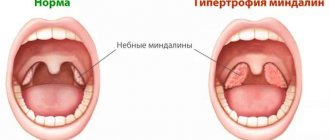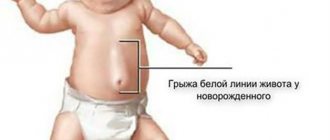Why does a baby's stomach growl?
Alarming symptoms
If you hear that your child’s tummy is rumbling during meals and some time after it, but the baby eats well, gains weight and is not capricious, then everything is fine with him. The fact is that such sounds accompany the digestion process: when the baby eats, the walls of his stomach and intestines begin to actively contract, which leads to rumbling.
Sometimes additional symptoms are added to the seething in the tummy. If you observe at least one of these in your baby, you need to show it to your pediatrician:
- The child is capricious during feeding and refuses to breastfeed
- The baby's belly swells and becomes hard to the touch.
- The baby has trouble sleeping
- The child presses his legs to his stomach, clenches his fists, arches his back
- The baby cries loudly in the evenings and cannot calm down
- The baby passes gas frequently
- The baby's stool becomes watery and green appears in it.
Causes of the "storm"
If rumbling in the stomach causes discomfort to the baby, colic and gas, a change in diet, lactase deficiency or the composition of the intestinal microflora may be to blame. After consulting with a pediatrician and taking tests, it will become clear which of these reasons is bothering your child.
- Infantile colic can appear in a baby from the second week of life and last up to four months. A newborn does not have time to digest the entire volume of milk or formula that he eats at one time. Residues of food settle on the walls of the intestines and begin to ferment, causing spasms - intestinal colic
- Changing the diet If you first fed your baby milk and then switched him to IV, this can cause digestive problems in the baby. Replacing formula and introducing complementary foods can also be a difficult challenge for a child’s body.
- Lactase deficiency Mother's milk and most formulas contain lactose - milk sugar. When it enters the baby’s body, its intestines begin to produce a special enzyme, lactase, which breaks down milk sugar. Babies often have problems synthesizing this substance, which is completely normal. By 4 months the problem should resolve itself. If the child gets worse, we are talking about lactase deficiency. This diagnosis must be made by a doctor. He will prescribe a special diet for the baby and prescribe medications.
- Imbalance of microflora At the beginning of life, the baby’s intestines are populated by “beneficial” and opportunistic bacteria. If the latter exceed the norm, the baby begins to have tummy problems. This could be dysbiosis or infection. To ensure that the baby does not experience complications, he needs to be taken to the pediatrician on time and tested.
Helping the baby
There are different ways to relieve your baby from a rumbling tummy. Your actions should depend on the reason that caused discomfort in the baby:
- For colic, give your baby a belly massage half an hour before feeding. While eating, make sure that your baby does not swallow excess air. After feeding, carry the baby in a column. To make your baby feel better, give him natural anti-colic drops “Koli Krokodil”. They begin to act within 10 minutes after administration, relieve cramps and bloating, and relieve pain.
- If you have problems with your diet, consult your pediatrician and choose a suitable formula for your baby. Eliminate from your menu foods that may cause digestive problems for the baby if he is on breastfeeding. Feed your baby more often and reduce portion sizes.
- For lactase deficiency If the doctor confirms this diagnosis, you will have to remove products containing lactose from the baby’s diet and switch the baby to special dairy-free formulas. Pediatricians often prescribe enzyme preparations to babies with lactase deficiency.
- If there is an imbalance in the microflora, you first need to get tested to assess the state of your child’s intestinal microflora. For dysbiosis, children are prescribed probiotics, and for intestinal infections - a special diet and medications.
Important! Any treatment must be carried out under the supervision of a specialist. Most often, rumbling in a baby’s stomach is a completely normal phenomenon that does not require your intervention and will go away on its own when the baby is 4 months old.
Obstructive bronchitis in children - symptoms and treatment
In the domestic literature, three forms of obstructive bronchitis :
- bronchiolitis;
- acute obstructive bronchitis;
- recurrent obstructive bronchitis (with bronchopulmonary dysplasia, obstructive bronchiolitis, etc.).
They all differ in symptoms and pathogenetic changes. However, in foreign literature, obstructive bronchitis and bronchiolitis are often described together, since both forms of the disease occur with bronchial obstruction [6].
Bronchiolitis mainly occurs in children under 2 years of age in response to respiratory syncytial infection, and less commonly to rhinoviruses. It develops gradually against the background of an initially mild ARVI, but later turns into a more severe form, leading to respiratory and heart failure.
Bronchiolitis is characterized by an abundance of moist, finely bubbly and crackling rales both on inhalation and exhalation, i.e. the picture of a “wet lung” is clearly expressed. With an increase in severe shortness of breath (an increase in the number of respiratory movements to 70-80 times per minute), breathing becomes shallow, and there are fewer moist, fine-bubbly and crackling rales. An increased inhalation is heard, the wings of the nose noticeably swell, and the symptoms of acute heart failure increase: cough, tachycardia, pale skin, enlarged liver.
Acute obstructive bronchitis most often occurs in children 3-5 years old, although it can also occur at older ages. Its development is associated with type 3 parainfluenza viruses, adenoviruses, influenza viruses and atypical pathogens. It develops both gradually and more acutely: with an increase in body temperature to 38-39 ° C, runny nose, nasal congestion and cough. Respiratory failure gradually increases with an increase in breathing frequency to 40-60 times per minute. It becomes harder for the child to breathe, so the body connects the muscles of the neck and shoulders to this process. Whistling sounds appear when exhaling.
Exhalation is difficult and prolonged. When tapping, a sound appears in the projection of the lungs, similar to the noise when beating on an empty box. On exhalation, scattered dry wheezing rales are more often heard, while on inhalation, moist, fine-bubbling rales are heard, i.e., the “wet lung” effect may not be heard in acute obstructive bronchitis.
Recurrent obstructive bronchitis can occur from the first year of life and then at any age. It develops more often in response to prolonged presence in the body of cytomegalovirus, Epstein-Barr virus, herpes virus type 6 and mycoplasma. Less commonly, it may be associated with common respiratory viruses. Often several causative viruses are found at once, especially in children who are often and long-term ill.
Bronchial obstruction usually develops gradually: against the background of normal or subfebrile temperature (up to 38 ° C) with slight nasal congestion, runny nose and rare coughing. Shortness of breath is mild, the respiratory rate rarely exceeds 40 movements per minute. The general condition of the child practically does not suffer.
When tapping, a pulmonary sound with a slight boxy tint is noted. When listening, scattered dry whistling rales against the background of emphasized exhalation are characteristic; moist rales during inspiration are not abundant or are completely absent.
According to the course of broncho-obstructive syndrome there are:
- acute bronchitis - the syndrome is present for up to 10 days;
- prolonged bronchitis - the syndrome persists for 10 days or more;
- recurrent bronchitis - the syndrome repeats 3-6 times a year;
- continuously recurrent bronchitis - the frequency and severity of the syndrome recur more than 6 times a year [6][7].
How to help a child with flatulence
As an advertisement
Today, the concept of flatulence in children of preschool and school age is found everywhere. The most common reasons for its development are disturbances in the digestion of food. We are talking about banal non-compliance with the diet, basic overeating and abuse of sweet and carbonated drinks. How to help a child with flatulence - we’ll talk further.
What is flatulence?
This is a characteristic condition when gases accumulate in the digestive tract. It is accompanied by severe bloating, increased gas production, belching, and cramping pain. In a healthy body, the passage of gases should occur from 5 to 20 times a day. But if this occurs more often and the process is uncontrollable, if it is accompanied by a foul odor or severe pain, you should consult a doctor. How is flatulence treated in children?
Treatment of childhood flatulence should begin with consultation with a specialist. This is important to exclude dangerous and complex diseases that can masquerade as flatulence.
As for the treatment tactics for flatulence, it has the following structure:
- Determination and treatment of the causes of flatulence. We are talking about etiological effects. In this case, doctors prescribe antibiotics (if an infectious disease is determined), anti-inflammatory therapy is carried out (if inflammatory bowel diseases are present), antispasmodics or enemas are prescribed (if the cause is mechanical gas retention), as well as probiotics to restore the natural intestinal microflora.
- Treatment with drugs that reduce gas formation. We are talking about pathogenetic treatment. Doctors prescribe drugs that actively absorb gases.
- Specialists may also prescribe the child to take antispasmodics if pain is present, or to take laxatives if symptoms of constipation are confirmed. This is a symptomatic treatment.
Natural correction
In addition, a diet is recommended for children with such problems. It consists of limiting a number of foods that can cause increased gas formation. Basically we are talking about a ban on fatty and refined foods (which are rich in carbohydrates), the exclusion of sweet and carbonated drinks, legumes, cabbage, freshly squeezed juices, and kvass. At the same time, fractional and frequent meals in small portions are encouraged.
If we talk about medicines, then first of all, you should pay attention to those that were created on the basis of natural and safe natural ingredients.
One of the brightest representatives of such herbal remedies is Gastritol, which can be given to children from 7 years old - 1 drop for each year of life, diluted in water, 3 times a day. For children over 12 years of age, the dosage, as for adults, is 20-30 drops, 3 times a day. It contains cinquefoil anose, which effectively relieves spasms in the intestines, as well as chamomile, which acts as a carminative, antispasmodic and sedative. Essential oils and azulene, which are also included in chamomile, in combination with bitter substances, have a positive effect on children's gastric mucosa. Angelica extract also enhances the beneficial effects. It has strengthening and stomach cleansing properties. This ensures a positive effect on the irritated gastric mucosa. It is worth noting that this effect is enhanced by the presence of licorice root extract in the drug Gastritol. It contains a complex of active substances that relieve irritation of the gastric mucosa and regulate the secretion of gastric juice and mucus. This ensures an optimal balance to quickly overcome the symptoms of inflammation in the intestines.
In addition, the drug also contains an extract of the herb St. John's wort, which promotes the final stage of the digestive cycle, which is often disturbed by flatulence. Even at the beginning of taking Gastritol, the child’s dyspepsia and pain stop, watery stools and gases disappear.
Treatment with the drug is possible only after consulting a doctor.
published 04/09/2014 10:26 updated 15/09/2014








